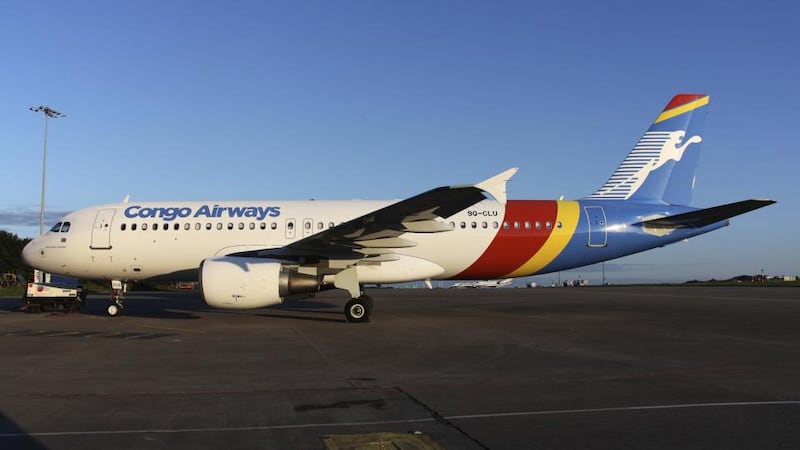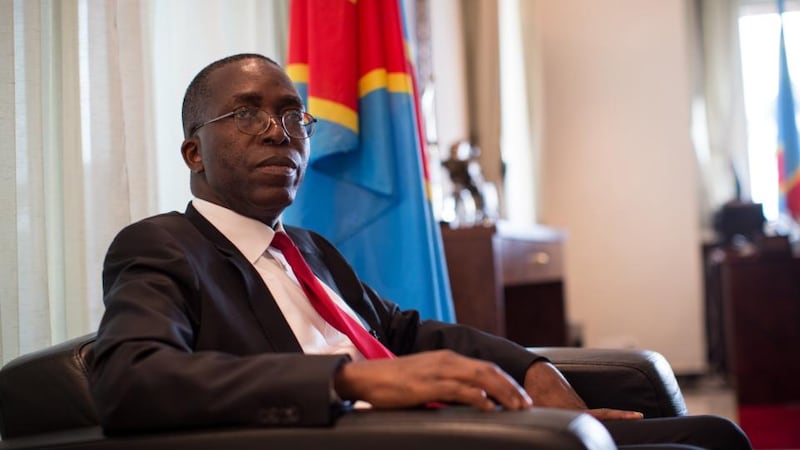In Ireland the case merited only a short story in this newspaper. "Congo aircraft held in Dublin due to debt," read the headline last weekend. But in the Democratic Republic of Congo the tale of the grounded aircraft was the top story.
The High Court here had grounded an Airbus A320 at Dublin Airport belonging to the new state airline of the Democratic Republic of Congo. The order had been sought by John Dormer Tyson and Ilunga Jean Mukendi, who said the Congolese government owed them €10 million following a dispute about the ownership of two diamond mines.
The plane, one of two Airbuses the Congolese state had just bought, had been sent to Dublin to be painted with the light blue, yellow and red of Congo Airways. It was to fly back to the Democratic Republic of Congo on August 25th, before a ceremony at Kinshasa, the capital, on August 30th to launch the flagship airline.


The grounding of the plane in Dublin is a setback for a country that has not had a functioning flagship airline since 1995, when Air Zaïre – the Democratic Republic of Congo used to be called Zaire – was declared bankrupt in a Brussels court.
On Monday the Congolese daily Forums des As wondered who had taken the case that led to the impoundment of the plane. Was it an attempt "to torpedo the efforts of the government?" It could only be enemies of the Democratic Republic of Congo behind the court case, the paper concluded.
When the news of the Dublin injunction broke, the Congolese government at first denied any delay to the launch of its airline. Prime Minister Augustin Matata Ponyo Mapon eventually took to Twitter to assert that the plane had been grounded “at the instigation of a Congolese national”. The prime minister assured his 10,700 Twitter followers that “this piece of our heritage will arrive” in Kinshasa.
The aircraft are of enormous symbolic importance to a Congolese government facing an election next year. When the first of the planes landed, fully painted and branded, in Kinshasa, Ponyo was waiting on the tarmac. After a tour of the aircraft he told the press that it was a “living symbol of patriotism”. Congo had paid for the planes in cash – they cost more than €45 million – from its own coffers, he told journalists, a sign that the country could “live up to its commitments”
The two planes are significant on a practical level, too, in a country with few passable roads – there are just 2,700km of tarmacked roads in a country larger than western Europe – and almost no reliable commercial air services.
The plan was for Congo Airways to start serving eight cities within the Democratic Republic of Congo, expand to 14 and then obtain a licence to fly first within Africa and then internationally.
But it is going to be a challenge for Congo Airways to fly outside the continent, as the EU has banned every Congolese airline from entering EU airspace. There are only a few flights a week between Europe and the Democratic Republic of Congo, all operated by European airlines.
The Democratic Republic of Congo has one of the world’s worst aviation safety records. That record has been described as an embarrassment by the International Air Transport Association. In 2012 President Joseph Kabila’s personal adviser, Augustin Katumba Mwanke, was killed in a crash in the eastern city of Bukavu when the plane he was on overshot the runway. Prime Minister Ponyo was injured in a plane crash that year.
The country’s airport infrastructure is also dilapidated.
One of the new planes has been named after Congo’s first democratically elected leader, Patrice Eméry Lumumba, who was assassinated in 1961. The other plane is to be named after the former president Laurent Kabila, who took power in 1997 (and who was Joseph Kabila’s father).
A notable absence is the name of Congo’s most notorious ruler, Mobutu Sese Seko, who seized power in 1965 and brutally exploited the country until his exile, in 1997. Mobutu renamed the country Zaire and brought in a programme of nationalisation that he called Zaireanisation. Mobutu looted Zaire’s wealth for his personal lifestyle and regularly commandeered Air Zaïre flights for shopping trips to Europe.
Michela Wrong, in her book In the Footsteps of Mr Kurtz, describes the palaces, pagodas, musical fountains and ornamental lakes Mobutu built at Gbadolite, a "Versailles in the Jungle" 1,000km northeast of Kinshasa. The airstrip there was extended to accommodate Concorde flights.
According to Wrong, Mobutu flew in mussels from Belgium, flowers from the Netherlands and hairdressers from France, all for his and his family’s use.
“Air Zaïre is dead. Congo Airways has been born from the ashes of Air Zaïre,” Ponyo told journalists as he visited the Congo Airways cockpit last week, strolling the cabin and telling the press that “we are living a renaissance” of the Democratic Republic of Congo.
The country is best known for its 20-year conflict, and renowned for poverty, sexual violence and shady deals exploiting its vast mineral resources. Its government says the country is emerging from conflict and has asked the UN to wind down its peacekeeping mission – 20,000 peacekeepers are still there, the biggest UN mission in the world.
The hold-up with the plane over unpaid debts doesn't sit well with the confident-sounding official rhetoric, which may have more to do with electoral calendars than with reality on the ground. Although growth is strong – the IMF expects the economy to expand by 9.2 per cent this year – the Democratic Republic of Congo still ranks 186th out of 187 countries in the 2014 UN Human Development Index.
Congo Airways is meant to mark a shift from its country flying the flag for failed states, and for the airline to represent a confident, independent country that can transport its citizens around and, one day, beyond its vast territory.
All Congolese eyes will be on the High Court in Dublin to see whether the case can be resolved and Congo Airways can take to the air.

















